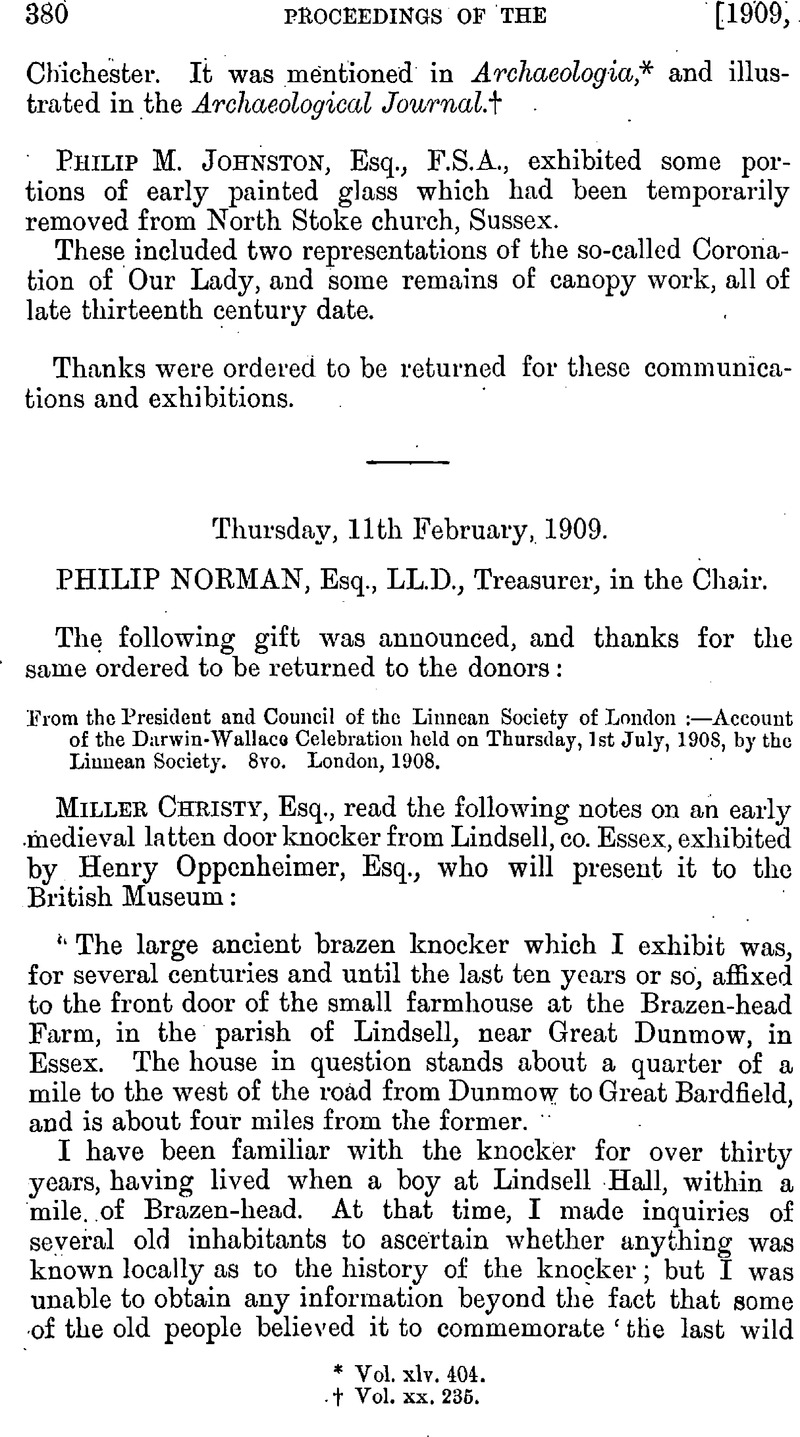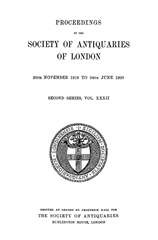No CrossRef data available.
Article contents
Thursday, 11th February, 1909
Published online by Cambridge University Press: 10 May 2010
Abstract

- Type
- Proceedings
- Information
- Copyright
- Copyright © The Society of Antiquaries of London 1909
References
page 380 note * Vol. xlv. 404.
page 380 note † Vol. xx. 236.
page 382 note * See the Visitations of Essex, 8, 51, 197, and 397 (Harl. Soc. 1878–9).
page 382 note † See Morant, History of Essex, ii: 445 (1768).
page 382 note ‡ Add. MS. 5524, ff. 190–191.
page 382 note § The brass is figured in Essex Review, vii. 40 (1898).
page 382 note ‖ Brazen-head continued in the possession of the descendants of this Thomas Fitch for more than two centuries. They were evidently of good standing and intermarried with the Wisemans and several other leading Essex families. A younger branch of the family was also seated at Canfield. In or about 1710, when Holman, the Essex historian, wrote, Brazen-head was the seat of Sir Francis St. John, Baronet.
page 383 note * For this information I am indebted to Mr. W. de Vins Wade, of Dunmow, Steward of the Manor.
page 383 note † Here the words “either of a deer or hind” have been erased.
page 383 note ‡ In the absence of any adequate explanation of the appearance of this fine knocker at the Brazen-head farm, it may even be worth while to point out that the arms of Fitch of Lindsell are vert a chevron between three leopards' heads gold (crest, a leopard's head gold, in his mouth a sword proper, hilted gules) and to suggest that, by some means unknown, some member of the Fitch family may have obtained possession of the knocker, and have had it affixed to the door of his house, because it reminded him of the armorial bearings of his family.
page 385 note * A passage in the Libellus de Admirandis Beati Cuthberti Virtutibus, by Reginald of Durham, written about a.d. 1150, refers, in all probability, to this knocker. The monk relates (p. 102, ed. Surtees Soc. 1835) that certain persons, “ following their leader, came to the very threshold of the Church of St. Cuthbert; when the said leader knocked loudly several times with the bronze rings which hang on the outer gates ; by which warning sound, he summoned the attendants watching within to unbolt the doors. These having been opened, the aforementioned leader spoke thus,” etc.
page 386 note * The Four Noses of Brasenose College, by Herbert Hurst, B.A. (7 pp. cr. 8vo., Taunt, Oxford, 1904), and The Name and Arms of [Brasenose] College (Brasenose Coll. Quatercentenary, Monogr. ii. 1909), by Falconer Madan.
page 388 note * Several examples, mostly of iron and of later date than the foregoing, are exhibited in the Cluny Museum (see Catalogue, pp. 465–466, and 472–473 : 1883).
page 388 note † Dict. Raisonné de l'Archit. vi. 81–86 (1863).
page 388 note ‡ Dict. de l'Ameublement, ii. cols. 1158–9, and iii. cols. 664–7 (?1889).
page 388 note § Reliquary and Illustrated Archœlogist, xii. 96–105 (1906).
page 389 note * Reproductions in the Victoria and Albert Museum.
page 389 note † Cat. of Early Christian Antiquities, No. 291. One has been discovered this year at Zula (Adulis) on the site of a church ascribed to the fifth or sixth cent. (Illustrated London News, Sept. 11th).
page 390 note * F. X. Kraus, Geschichte der Christlichen Kunst, ii. 211 ff. Other early German examples are here mentioned.
page 390 note † For these doors see H. W. Schulz, Denkmäler der Kunst des Mittelalters in Unteritalien, i. 243 ff., ii. 228 ff., 285, and Atlas, pl. xxxix. lxxxv. ; E. Bertaux, L'art dans l'Italie méridionale, i. 403 ff.
page 390 note ‡ On Italian examples quite a number of lion masks are found on a single door, in one case there is a row along the top, showing that they were merely intended as ornaments.
page 390 note § F. X. Kraus, as above, p. 214.
page 392 note * Victoria History of Kent, i. 381–2.
page 392 note † Engraved in Archaeologia, xviii. pl. xvii.
page 392 note ‡ 2nd. S. viii. 153.


